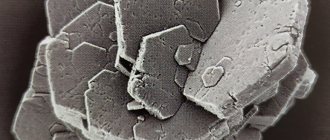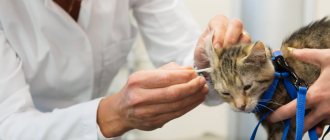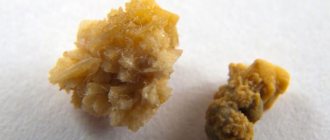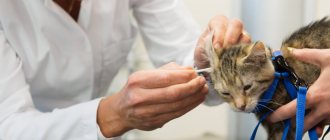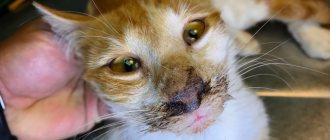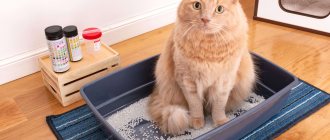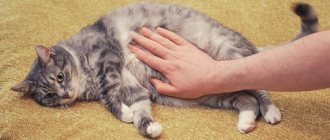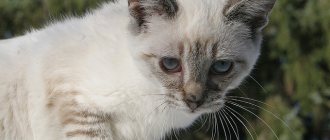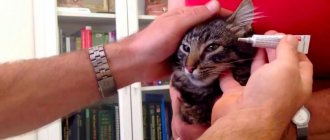Learn about the causes, symptoms and treatment methods for urolithiasis in cats. Diseases are best prevented, so read about prevention.
Urolithiasis in cats or urolithiasis is the formation of sand and urinary stones in the kidneys or bladder, which can pass or remain in the ureters and urethra, accompanied by the release of blood into the urine.
Every fourth cat is susceptible to urolithiasis, or urolithiasis for short. It is difficult to accept this fact, but it is necessary - your cat is at risk!
So, 14% of domestic cats are at risk of being diagnosed with urolithiasis or urological syndrome - each of them hides a metabolic disorder in the body of cats, which leads to the formation of stones and their deposition in the genitourinary system.
Who suffers more often?
- Cats, because in males the diameter of the urethral lumen is several times smaller than in females
- Not sterilized cats. According to statistics, cats that have not undergone sterilization suffer from urolithiasis twice as often as non-neutered cats.
- Animal aged 2-6 years
- Overweight cats
- Long-haired cats (Persian, Siberian, etc.)
- Neutered cats
Doctors have noticed that urolithiasis in cats is especially aggravated with the beginning of autumn and from January to May.
Urinary cylinders
Precipitates without a specific structure. They are formed from exfoliated tissue elements, blood and inflammatory cells, and a large amount of matrix substance. Crystalline components are not always present in urinary cylinders. If they are found in mineral components, they are often formed by struvite. Uroliths and casts are physically different and occur for different reasons and are more often found in males than females. The urethra is narrower in cats and urinary cylinders can cause partial or complete obstruction. Idiopathic cystitis is one of the factors contributing to the formation of urinary casts.
In case of obstruction of the urinary tract by urinary cylinders, it is necessary to eliminate the obstruction of the urinary tract and restore urine flow, restore the acid-base balance of the body, the balance of fluids and electrolytes.
"Home Cooking"
It is necessary to limit the intake of proteins, calcium and oxalic acid. Dairy products are completely excluded from the pet's diet . Source of protein - boiled chicken (occasionally), legumes. It is recommended to give your cat cabbage boiled in meat broth and pureed.
If you have the opportunity to sometimes feed your pet with specialized medicinal foods, follow a simple rule - they should always (!) be given separately from regular food , avoiding mixing of these products.
Idiopathic | feline interstitial cystitis
An inflammatory non-infectious psychoendocrine disorder, the pathogenesis of which involves the hypothalamic-pituitary-adrenal part of the endocrine system and the central nervous system.
Cats can be born with this predisposition and under certain stressful conditions this disease manifests itself. FIC is a chronic disease that is mild and resolves spontaneously. Relapses are common due to stressful situations. In sick cats, there is a decrease in the size of the adrenal glands.
Cats with idiopathic cystitis are often aggressive, nervous, and fearful.
FIC affects cats under the age of 10 years, without health problems; more often the animals eat only dry food. The relative density of urine is significantly increased in a large number of animals.
Hemorrhagic cystitis - drops of blood are present in the urine.
Calculous cystitis – sand, stones are deposited in the bladder.
Bacterial cystitis is characterized by the presence of bacteria in the urine; normally, urine is bacteria-free and sterile.
Scheme reflecting the proposed pathophysical changes in cats with idiopathic cystitis
How to treat idiopathic cystitis
The main thing is to eliminate stress factors affecting the sick animal.
Irritants:
- Inconvenient location of the toilet;
- Owner's daily routine;
- Change of weather;
- Low mobility of the cat;
- Food;
- Type of filler;
- Strangers and animals in the house.
How to mitigate the effects of stress:
- High complexes for cats;
- Toys that can be chased;
- Various devices for the manifestation of instincts.
Nutrition plays an important role in the pathophysiology and treatment of interstitial cystitis. Sudden and frequent changes often lead to relapses of the disease. The clinical condition of cats improves wet food, reduces the relative density of urine.
A diet with a very low pH is not recommended for cats suffering from FIC, because a decrease in urine pH leads to an increase in the level of irritation of nerve receptors located in the bladder, which creates a feeling of pain in the cat.
Symptoms of the disease by stages
When the disease just begins to develop, it is very difficult to notice. Symptoms at the primary stage are not clearly expressed, so the owner does not pay attention to minor changes in the cat’s behavior. The furry friend becomes apathetic, does not want to be active, eats poorly, and experiences discomfort when going to the toilet.
Sometimes owners learn about a dangerous pathology when drastic measures are required. When solid formations form, the main symptoms can already be clearly seen. Their intensity is divided into three degrees:
1. Initial stage.
The cat takes a long time to go to the toilet, and it will relieve itself in a variety of places - psychologically, the litter box begins to symbolize pain and discomfort. The posture when urinating becomes unusual, the animal becomes very tense. After visiting the tray, your furry friend will lick under the tail for a long time and thoroughly. Little urine is produced and may have a pinkish tint. Sometimes grains of sand are visible in it. The urge to go to the toilet becomes frequent. A cat on a tray often meows due to pain.
2. Acute stage.
The urge to go to the toilet becomes frequent. It happens that the animal experiences incontinence: the four-legged friend will leave wet spots in the resting place, and the owners also notice droplets in his crotch. The stomach becomes denser. Blood is already clearly visible in the discharge. Urine is released drop by drop and has a dark color with a concentrated odor. The pet's condition will be very depressed and lethargic. He usually loses a lot of weight, loses his appetite, and does not play with his favorite toys. Body temperature in some cases rises to 40 ˚С. As the stones move through the urinary canal, the cat will meow restlessly and take a characteristic position to relieve the pain.
3. Critical stage.
Your pet may completely stop going to the litter box. At the same time, painful urges will persist. The discharge will stagnate, causing intoxication of the body - often causing vomiting. Your furry friend will be constantly shaking. In the corners of the mouth you can notice accumulated saliva, viscous and foamy. The stomach will become painful and the cat will almost stop moving. If there is no urination, then after 24-36 hours the reabsorption of waste products begins. Body temperature drops slightly. There are convulsions and loss of consciousness.
It is especially important to see a doctor in the last stage. This condition is considered critical and dangerous for the animal. At this time, minutes count – you can save your pet’s life only by quickly delivering him to a veterinary clinic.
Urine stones | uroliths
They are formed from poorly soluble crystalloids in the urinary tract. Visible to the naked eye - uroliths, detected under a microscope - are called crystals.
When urine is oversaturated with certain inorganic compounds, urinary crystals form. These compounds begin to precipitate as supersaturation increases. Urinary stones begin to form with the formation of their crystalline core. The growth of crystals depends on the duration of urine supersaturation, the ability of the urolith core to remain in the urinary tract, and the physical ultrastructure of the crystals. A number of factors influence the growth rate of uroliths: their mineral composition, the presence of infectious agents in the urinary tract, etc.
Relative supersaturation of urine
The main reason for the formation of crystals in the urinary tract is oversaturation of urine. Crystallization potential determines the level of relative supersaturation of urine.
The level of relative supersaturation of urine created by each type of crystal is specific.
Three states of urine saturation:
- Undersaturation;
- Metastable saturation;
- Oversaturation.
Relative supersaturation of urine
To assess the risk of urolith formation in the patient’s urinary system, each of them has special significance. A higher RSS of urine means a higher risk of crystal formation, and with a low RSS the risk of urolith formation becomes less significant.
Assessing the risk of struvite urolith formation based on RSS level
Assessment of the risk of calcium oxalate urolith formation based on RSS level
Stimulation of diuresis
The easiest and most effective way to treat all forms of FLUTD is to increase urine volume and stimulate diuresis. With a large volume of urine, the animal urinates frequently, which helps remove formed crystals, protein-containing material and cellular debris from the urinary tract. Diluting urine, accelerating its flow, has a beneficial effect on cats with urinary plugs and urinary tract.
To stimulate diuresis, your pet should drink more.
How to increase your cats' water intake:
- Increase the amount of canned or dry food intended to stimulate diuresis in the animal’s diet;
- Feed the animal often, but in small portions;
- Provide the animal with access to water at any time;
- The water bowl should be wide and fill to the brim;
- Give animals different types of water: filtered, distilled, bottled, warm running, cold running;
- Don't sweeten the water: cats don't have taste buds that recognize sweets;
- Adding fragrances to water. A number of companies produce various aromatic additives for drinking water to stimulate its consumption;
- Some cats prefer running water (drinking fountain);
- It is important to keep the water bowl a good distance from the cat's litter box;
- Some cats prefer glass bowls, others prefer ceramic or metal;
- Generally, cats do not like to share their bowl with other animals (especially dogs).
The more often a cat is fed per day, the more the pet drinks.
If the feed is of reduced digestibility, then water loss with feces increases. Cats with FLUTD should be given a highly digestible diet to reduce water loss through feces.
Increase the sodium content in the diet to increase the cat's water intake and dilute the urine.
Adjusting urine pH
Acidification of urine significantly increases the solubility of struvites and is quite sufficient for the dissolution of this type of uroliths. In contrast, alkalinization of urine is important for increasing the solubility of metabolic uroliths, including some urate and cystine urinary stones. It is not recommended to increase urine pH to more than 7.5, as this may cause the development of calcium phosphate uroliths. Calcium oxalate uroliths form in urine at any pH, and, as far as is known, there are no effective medications that can ensure their dissolution.
Diagnostics: how to identify pathology
It is important to quickly identify the problem so that you can deal with it and save the life and health of your four-legged friend. To do this, at the slightest suspicion of genitourinary problems, you need to take your pet to a veterinary clinic. The specialist will ask you to describe the cat’s behavior in detail, and then prescribe the necessary studies.
Unfavorable changes can be identified using x-rays, ultrasound, and also by studying the sediment of the discharge in the laboratory and determining the type of salt formation. The composition of the crystal will allow you to understand what kind of prevention and therapy needs to be carried out. The clear presence of salts is determined by qualitative analysis methods: light microscopy, Xray diffraction, etc. The specialist will also prescribe a blood test.
At the appointment, you need to accurately and in detail tell about all the details of keeping the pet, its physical condition, diseases, when the first signs of deviations began to be observed, etc.
Struvite, risk factors, treatment
Struvite uroliths form when urine becomes oversaturated with magnesium, ammonia and phosphate, and its pH rises to more than 6.5. The solubility of struvite crystals increases at urine pH below 6.5, and at a level of 6.3 struvite stops crystallizing altogether. However, the pH value of urine decreases if animals are fed a diet that promotes increased diuresis and decreased urine concentration (wet food).
Magnesium. Diets containing 0.15-1.0% magnesium (dry matter basis) were associated with the formation of struvite urinary stones in cats. However, the degree of influence of magnesium depended on the form of its compounds and on the pH of the urine.
Phosphorus. With a diet high in phosphorus (3.17-4.70 g/1000 kcal), the incidence of struvite urolithiasis in cats was almost four times higher than in animals fed a diet with a phosphorus concentration of 0.85-1 .76 g/1000 kcal. A high level of phosphorus consumption is accompanied by a more intense excretion in the urine and, as a result, induces its oversaturation with magnesium, ammonia and phosphates.
Treatment
Relief of urinary tract infections. To treat cats, it is necessary to combine dietary therapy with the use of antimicrobial drugs.
It is possible to achieve the dissolution of urinary stones formed by struvite using diet therapy. For this purpose, a diet is used that provides an increase in the volume of urine excreted and a decrease in its pH to a level of 6.3 or less. Such a diet allows you to control the animal's magnesium intake and ensures that the RSS of urine is maintained below unity (the unsaturation zone). It must contain sodium in such an amount that the animals consume more water and produce unconcentrated urine. Sterile struvite uroliths do not require additional antimicrobial therapy.
Prevention of recurrence of urolithiasis. The recurrence rate of struvite urolithiasis in cats is 2.7% with an average duration of remission of 20 months. Therefore, after dissolution or mechanical removal of uroliths, special diets are recommended for cats. This type of preventive diet should maintain urine RSS in areas of unsaturation or metastable saturation, lower urine pH to 6.5 or less, contain plenty of moisture (canned food or other wet foods), and promote increased diuresis (due to increased sodium chloride).
X-ray of the abdominal cavity, the arrow shows a large single urolith
Struvite uroliths from the bladder
Struvite uroliths of various types
Predisposing factors
By the way, what are the causes of ICD? All this can be triggered by: a urinary tract infection, an unhealthy diet, intestinal diseases (don’t be surprised - in this case, something that should not normally be absorbed into the blood begins), a small daily volume of urine excreted, low frequency of urination, and certain medications. It is known that some animals have a genetic predisposition . By the way, it is strongly recommended to exclude them from the reproduction process.
Disease often develops from dry food : pets who eat it regularly suffer from urolithiasis 70% more often than cats receiving normal nutrition. And further. This pathology is very common in cats whose owners “pamper” their pet with raw fish: it contains a lot of calcium, phosphorus and other elements that can contribute to the development of urolithiasis.
Advice - if you feed your cat river fish (this applies to a lesser extent to sea fish), be sure to scald it with boiling water!
Firstly, this somewhat reduces the likelihood of parasitic pathologies. Secondly, it will prevent the production of excess urea. Thirdly, boiling water neutralizes thiaminase, an enzyme found in raw fish that destroys vitamin B1.
In addition, urolithiasis is a common consequence of gastrointestinal accompanied by poor absorption of nutrients. In such cases, Tsamax is indicated, since this drug improves the absorption of nutrients, vitamins and microelements. Finally, let us once again emphasize the role of infectious diseases. How do they even contribute to the formation of urolith crystals? It's simple: many bacteria secrete substances that promote “gluing” and sedimentation of compounds contained in urine and under normal conditions are not prone to the formation of “sedimentary rocks”.
Calcium oxalate
The average age at which most cats are diagnosed with urolithiasis is 7.8 years (but it can occur in animals between 2 and 18 years of age). The risk of calcium oxalate uroliths increases in older animals.
Most often, this type of urolithiasis affects males (55%) - in females, calcium oxalate urinary stones are found approximately 1.5 times less often.
Burmese, Himalayan and Persian cats have a predisposition to the formation of calcium oxalate uroliths, which suggests the existence of genetic factors that contribute to the development of this type of urolithiasis. Keeping cats exclusively indoors is an additional risk factor for the development of calcium oxalate urolithiasis.
Calcium oxalate uroliths
Effect of metabolic acidosis on urinary calcium excretion
Under conditions of metabolic acidosis, the release of calcium phosphate and carbonate from bone tissue is stimulated, which enter the blood, where they perform buffering functions. Excess calcium is excreted in the urine, which increases the risk of calcium oxalate uroliths.
Treatment and prevention of relapses
Calcium oxalate uroliths are not amenable to drug treatment. Therefore, urinary stones found in the bladder must be removed mechanically - by washing them out of the urinary tract with water under high pressure or surgically.
You should avoid dry foods that are not intended to reduce urine pH, as well as medications that increase the excretion of calcium from the body in the urine (urine acidifiers, furosemide, and others). Such cats should not be given treats or food additives containing calcium, vitamin D or vitamin C in increased quantities, as they increase the excretion of calcium and oxalates in the urine.
Formulate your cat's diet to maintain a urine pH of 5.8-6.2, thereby ensuring a low (below 5) RSS of urine calcium oxalate. It is necessary to ensure that cats consume more water - this is the main factor in the treatment and prevention of calcium oxalate urolithiasis.
Treatment approaches for localization of urinary stones in the kidneys and ureters
Removing urinary stones from the kidneys surgically (nephrectomy) entails the inevitable loss of nephrons. Therefore, this method of treatment is not recommended until it becomes clear that the uroliths located in the kidney are indeed causing serious illness in the animal. The indication for dissection of the ureter in order to remove uroliths from it is the progressive development of hydrocele of the renal pelvis. The operation is performed only if there is indisputable evidence that urinary stones are localized in the ureter. After such surgery, cats may experience complications such as urine accumulation in the abdominal cavity and ureteral stricture. An alternative to surgical treatment is conservative therapy.
Standard clinical picture
The characteristic symptoms associated with urolithiasis are extremely rare if there is only fine sand and small crystals in your pet's urinary tract. But this is not always the case: the exception is cases when the formation of uroliths occurs in the lower parts of the urinary tract. They are constantly in motion (that is, during the act of urination), injuring and wounding the mucous membranes of the urinary tract. This leads to dysuria, hematuria and even stranguria (difficulty, painful urination).
nephroliths do not manifest themselves in any way , but this is only true for those cases when the pathology is not accompanied by pyelonephritis, or when the stones do not “squeeze” into the urinary ducts. The latter situation, by the way, is especially difficult. It is accompanied by vomiting, and the development of lethargy and renal colic is likely. When the stone is large enough and tends to grow, it begins to literally stretch and tear the renal pelvis. The pain is so severe that the animal can die from painful shock. Even if his pain threshold is high, the pet still runs the risk of dying from severe internal bleeding.
The life expectancy of pets with this disease (without any treatment) drops by two to three times. A sick cat is unlikely to live beyond the age of five or six, unless she is very lucky. Timely initiation of therapy helps not only to maintain the quality of life, but also to significantly increase its duration.
The problem is that with unilateral urolith (when only one ureter is clogged), there may not be any signs for a long time. Until one of the kidneys, from which urine drainage is difficult, “blooms” with cysts. In addition, this condition is fraught with the development of nephrosclerosis, and with this pathology the organ completely ceases to perform its physiological function. Animals who develop hydronephrosis as a result of blockage of the urinary ducts are also “lucky”. In most cases, nothing can help their kidney; the organ has to be removed surgically. If you already have kidney problems, the appearance of stones in them further aggravates the pathological process.
And one more “unpleasant” feature of the kidneys: they contain millions of nephrons, and the organ ceases to function fully only in those cases when at best 1/5 of their initial number remains from this enormous accumulation of cells. Simply put, the clinical picture of renal failure often becomes obvious only when at least one kidney is gone . But this is the best case scenario. Most often both fail. Thus, the clinical picture appears relatively quickly only in one of the following three cases:
- Both ureters turned out to be blocked . This situation is especially likely when many small stones form in the urinary system. Sooner or later, at least one of them will “climb” into the urethra.
- Already have chronic kidney disease (sometimes homeopathy helps to control it).
- An infection was added to the pathological process .
Calcium phosphate uroliths
The cat is examined for the presence of high concentrations of calcium and/or phosphate in the urine, hypercalcemia, primary parathyroidism, and alkaline urine (pH > 7.5). If the patient’s primary disease could not be diagnosed, against the background of which calcium phosphate urolithiasis developed, then they resort to a treatment strategy similar to calcium oxalate urolithiasis. However, the necessary precautions should be taken to prevent an excessive increase in urine pH, which often happens when a cat receives special food intended for the treatment of calcium oxalate urolithiasis.
What to feed a cat with ICD
When treating a cat for urolithiasis, be sure to use special food for cats with urolithiasis. They have a balanced composition of nutrients, minerals and vitamins. The type of cat food is chosen depending on what stones have formed in the genitourinary system. Natural nutrition is selected individually, but in any case it is recommended to avoid seafood and dairy, as they are saturated with mineral salts.
Diet for oxalate stones
Food should contain a minimum of oxalic acid. If the pet is on homemade food, then offal (liver, kidneys), as well as dairy dishes containing a lot of calcium, should be temporarily excluded. The therapeutic diet includes meat, vegetable stew made from cauliflower, carrots, beets and pumpkin, and rice porridge. If you buy ready-made food for your cat, you need to carefully choose the variety. For oxalate stones, the following is suitable for a cat:
- Hill's Prescription Diet Feline K/D or X/D
- Royal Canin URINARY
- Eukanuba Oxalate Urinary Formula
Hill's Prescription Diet Feline X/D. It has a reduced concentration of calcium and phosphorus, but an increased amount of potassium citrate and soluble fiber. This dietary food should not be fed to pregnant cats, young kittens or cats with struvite crystallization. Hill's Prescription Diet Feline brand K/D is used for stones of any nature.
Royal Canin URINARY is used for both therapeutic and preventive nutrition. It increases urine output and inhibits the formation of stones. The food has limitations - high blood pressure and abnormalities in kidney function.
Eukanuba Oxalate Urinary Formula is a low-calorie dietary food with reduced calcium and fat content. Ingredients are chicken, turkey, egg, cornmeal. Wet food comes with fish. Contraindications include pregnancy, lactation, and under one year of age.
Diet for struvite
Phosphate stones, which form in an alkaline environment, require a change in pH to the acidic side. This is partly facilitated by medicinal food or a properly selected diet of natural products. The cat should not be fed dairy products (cottage cheese, cheese, milk), or egg yolks. It is recommended to prepare dishes from oatmeal, rice, liver, egg whites, lean beef and veal. An alternative could be:
- Hill's Prescription Diet Feline S/D, C/D
- Eukanuba Struvite Urinary Formula
Hill's Prescription Diet Feline S/D is a medicinal food that fully meets the nutritional requirements of this category of cats. The composition contains meat, chicken fat, rice, corn flour, starch. This food should not be offered to small kittens under one year old or pregnant cats.
Eukanuba Struvite Urinary Formula. It is used for struvite crystallization and tendency to fullness. Dry granules are made from corn grits, chicken, turkey, animal fat, and dried eggs. This variety is not given to pregnant and lactating females and small kittens.
Urate uroliths
These uroliths consist of uric acid and the monobasic ammonium salt of uric acid (ammonium urate). Urates are found less frequently (<6%) than struvite and calcium oxalate.
Formed in animals with portosystemic anastomosis and in various forms of severe liver dysfunction, they usually contain struvite.
Urate urinary stones
Urate uroliths occur:
- for urinary tract infections accompanied by an increase in the concentration of ammonia in the urine;
- with metabolic acidosis and highly alkaline urine;
- when receiving a diet rich in purines (made from liver or other internal organs).
What kind of disease is this?
Urolithiasis (UCD) or urolithiasis is a chronic disorder that affects the urinary organs. Pathology occurs as a result of the formation of salt deposits inside the bladder or kidneys. In cats, this disease is accompanied by the formation of stones of different types:
- Struvite. They have a solid structure and are formed in an alkaline environment. The enrichment of urine with alkali occurs due to excess magnesium and phosphorus in food. In 80% of cases with urolithiasis, these formations are detected.
- Oxalates. They are looser and sharper. Formed when the pH becomes more acidic due to increased calcium in food. Oxalates usually form in older animals.
It should be noted that KSD often leads to death if the pet owner does not take care of timely treatment.
Cystine uroliths
Cystine uroliths are formed in cats with cystinuria, which occurs as a congenital disorder of the reabsorption of cystine and other amino acids (ornithine, lysine, arginine) in the proximal tubules of the kidneys. In most cases, cystine uroliths are found in aging cats.
Small cystine uroliths can be removed from the urinary tract by flushing it with high pressure water. Large urinary stones must be removed surgically (through cystotomy).
Electron microscopy image of cystine urolith
Reduce the content of methionine and cystine in the diet while using drugs containing thiol.
Alkalinization of urine. The solubility of cystine depends on the pH environment; it increases in alkaline urine. You can increase the pH of urine by using a diet containing potassium citrate or by giving animals this drug orally.
First aid
Let us immediately warn you that even first aid can only be provided in a normal veterinary clinic, since you cannot do anything at home. So, if there is a suspicion that the urethra is blocked by urolith, it is necessary to remove this obstacle. In very rare cases, it is possible to do this mechanically, by gently massaging the area of the S-shaped bend (in males). But more often, the veterinarian uses a sterile catheter: it is inserted into the lumen of the urethra and the “cobblestone” is pushed back into the cavity of the bladder. In “advanced” clinics they can destroy stones with a laser.
Unfortunately, this is not always possible. Firstly, the stones are too big. Secondly, the risk of mechanical damage to the urethra is quite high. Therefore, surgical treatment of urolithiasis in cats is used: the lumen of the urethra is opened with the simultaneous evacuation of its “foreign” contents. It is strongly recommended that the extracted stones be sent for chemical testing, as this will provide important data regarding the chemical nature of the urolith. This will help in further prescribing treatment and a suitable diet for the pet.
Xanthine uroliths
They are rare. The formation is associated with a congenital disorder of purine metabolism, or they are formed as a result of cats receiving allopurinol orally.
Diet therapy strategy: reducing the purine content in the diet, high water consumption, giving wet food.
Treatment of uric acid with allopurinol should be stopped immediately - the drug promotes the formation of xanthine uroliths.
Xanthine urinary stones
Diet therapy
If the animal's condition is relatively stable, special feeding may be used. Its goal is to reduce urine pH to <6. Today, by the way, many commercial feeds are produced (we will write about some of them below) that help quickly solve this problem. You need to reduce your daily intake of protein, phosphates, magnesium and sodium . If everything is done correctly, the daily reproduction of urea will sharply decrease, but urine production, on the contrary, will increase. As a result, fine sand and stones will simply be washed out of the urinary system or (over time) dissolved.
There is one “subtlety”. During this time, your cat should not eat anything other than the diet prescribed by your veterinarian. Otherwise, no positive effect will be achieved.
To make your pet’s life more “colorful” and not starve him, you can use any medicinal food from Royal Canin, Purina and others like them.
Such diets are developed specifically for weakened animals and are recommended for use during the period of rehabilitation after serious illnesses, as well as for feeding pets with urolithiasis.
To ensure nutritional appeal for cats with weakened immune systems, when developing food, the taste characteristics of these animals were taken into account; the food is saturated with flavoring compounds that help awaken the pet’s appetite. The products contain easily digestible oligosaccharides and fats. The high nutritional value that they possess allows you to give the animal a smaller amount of feed, but at the same time fully provide its daily need for nutrients, micro and macroelements, and vitamins.
In addition to simple oligosaccharides, beet pulp is used in the production of the product. It is a source of complex carbohydrates and fiber that stimulate intestinal peristaltic activity. What if you don’t have the opportunity to give your pet something similar?
Silicate uroliths
Silicate uroliths are rare in cats and this pathology is recorded in cats more often than in cats. There is a definite relationship between the incidence of this type of urolithiasis in cats and the use of plant-based foods (large amounts of fiber or bran). Cats need to be given more to drink.
Silicate urinary stone
Uroliths formed by dense blood clots
Prevention measures
Prevention of urolithiasis in cats is as follows: avoid economy-class food (Kitiket, Whiskas, etc.). They provide premium industrial food (Hills, RK, Belkando, etc.) and super-premium class (Purina van. Kimiamo, Bosch Sanabel, etc.). A veterinarian or a consultant at a pet store will tell you in detail about the brand of acceptable food for struvite and oxalate stones.
Diet for ICD
If it is not possible to purchase specialized feed, which is expensive, you can make up your own diet. Nutrition depends on the type of stones found in the cat. General principles:
- Severely limit foods high in calcium (eggs, milk, cottage cheese, etc.).
- Include meat with pumpkin, Brussels sprouts, vegetables that do not contain Ca and alkali.
- Do not mix industrial and homemade food.
- Avoid monotony in feeding.
- With oxolates, exclude the kidneys and liver.
- Water is always available, preferably filtered.
- Preferred meats: beef, lamb, chicken (breast). They are supplemented with: rice, oatmeal, cauliflower, lean fish.
- When urates occur, rich broths, offal, cheap dry food, and sausages are removed.
The diet is prescribed for life. You cannot feed a cat with ICD with leftover food from the table; it is prepared for it separately. Even with successful treatment, but failure to comply with subsequent preventive measures, the disease returns. The condition of a cat with urolithiasis is monitored every 6-8 months. They do an ultrasound of the bladder and kidneys, and take a urine test. It is not recommended to carry out treatment on your own, based on the information from the article. The owner must recognize the symptoms of urolithiasis in a cat in time and take the pet to a veterinary clinic, where he will undergo the necessary manipulations to relieve the disease.
Complex uroliths
Consist of a core formed by one type of mineral and a stone or shell formed by another type of mineral. They are formed in cases where factors first act to promote the crystallization of one mineral, and then conditions arise under which crystallization of another mineral occurs. Some types of minerals may also function as a core upon which further deposition of other inorganic substances occurs. All types of uroliths contribute to the development of urinary tract infections, which, in turn, accelerate the precipitation of struvite.
Complex urolith. The core consists of acid ammonium urate, the shell is made of struvite
The dietary therapy strategy is to eliminate factors that contribute to the formation of complex urinary stone nuclei. It is recommended to give sick cats wet food or add water and sodium to it: this helps reduce the saturation of urine with components from which uroliths are formed.
Diagnostic techniques
Cases where urethroliths block only one ureter, and there are no symptoms in the background, can be detected in the early stages only by chance, during a routine veterinary examination.
If the pathology has gone far, and there are a lot of stones in the urinary organs (or few, but they are large), it is possible to determine urolithiasis by palpation of the walls of the bladder. The wall of the urinary organ will be thickened, and during palpation you will feel a specific “crunching” sensation. Unfortunately, it is not possible to classify this technique as reliable, even if one wants to. Firstly, it is not always possible to palpate the bladder normally. In addition, the “crunching” can be explained by other reasons that have nothing to do with the presence of stones. If there is a suspicion of urolithiasis, the veterinarian can use a catheter: with its help, you can easily determine whether the lumen of the urinary canal is blocked by some foreign object. In addition, the catheter will help remove some sand (if there is any, of course).
Of course, this technique does not belong to the category of particularly accurate ones. Since in severe cases stones can appear in any part of the urinary system, a complete X-ray examination is indicated. If there is at least one stone whose diameter reaches approximately 3 mm, it will be visible on the x-ray.
As we mentioned above, even an x-ray examination does not guarantee a 100% result: many types of stones are formed by minerals that are “transparent” to x-rays. They simply pass through the uroliths, as a result of which no threatening signs remain on x-rays. Much more reliable than ultrasound : ultrasound cannot pass through solid obstacles in any case.
In addition, a microscopic examination of urine is indicated: if there are stones in the urinary system, their particles will definitely be in the field of view of the device. If an infectious etiology of the process is suspected, the resulting material must be sown on a nutrient medium.
Treatment of urolithiasis with folk remedies
Treatment at home without a correct diagnosis is risky; you should find out the type of stones. At home, you can safely only stimulate diuresis.
If the composition of urinary stones is not known:
- Dandelion root is a strong diuretic. Collect dandelion roots in the fall, after the first frost. Without peeling off the black skin, rinse with cold water and dry in the open air for four days. Then cut and dry. Take a 0.5 liter jar, fill ¼ of the jar with dandelion root, add hot water, leave for 14 days. The cat should be given before meals: add 6-9 drops of infusion to a tablespoon of water, give 3-4 times a day, course 7 days;
- The rice loosens and removes stones. Pour 1 liter of cold water over 2 tablespoons of rice overnight. In the morning, rinse the rice in a colander, add 1 liter of cold water, bring to a boil and cook, stirring for 7 minutes. Then drain the rice into a colander and pour boiling water over it. Rice is given to the cat in the morning on an empty stomach; you can feed it the usual diet after 2 hours. Rice removes calcium, so you need to give calcium tablets for cats or cottage cheese, milk;
- Celery – anti-inflammatory, wound healing effect. Celery root and greens are passed through a blender or meat grinder. Mix 0.2 kg of celery with 0.2 kg of honey. Leave in the refrigerator for 10 days. The cat is given 0.5 - 1 teaspoon 3 times a day.
If the composition of urinary stones is known, then use the following:
- Phosphorus stones. Mix 5 parts licorice root, 5 parts horsetail, 4 parts motherwort, 4 parts St. John's wort, 3 parts birch buds, 9 parts bearberry, 4 parts peppermint, 4 parts juniper, 4 parts yarrow, 3 parts rose hips, 9 parts buds. pears, 9 parts of lingonberry leaves. Pour 1 tablespoon of the mixture into 200 ml of boiling water. Give the cat 1 tablespoon before meals 4 times a day, course 7 days;
- Pyelonephritis due to urolithiasis. Mix 2 parts curly parsley, 2 parts strawberry herb, 1 part St. John's wort, 1 part juniper fruit, 2 parts horsetail, 2 parts bearberry, 2 parts knotweed. Pour 1 tablespoon of the mixture into 200 ml of boiling water. Give the cat 1 tablespoon before meals 4 times a day, course 7 days;
- Oskolate and urate stones. Mixtures are used. The first is 1 part rose hips, 2 parts knotweed, 1 part wheatgrass rhizome, 1 part flax seeds, 1 part corn stalks with stigmas, 1 part strawberry leaves, 6 parts tops of oat inflorescences. The second is 2 parts of dill seeds, 3 parts of bearberry leaves, 2 parts of Chernobyl, 3 parts of carrot seeds. Pour 1 tablespoon of the mixture into 200 ml of boiling water. Give the cat 1 tablespoon before meals 4 times a day, course 7 days;
- Phytotherapy. For 7–14 days, give 0.5 teaspoon of fresh knotweed juice 3 times a day, immediately wash it down with fresh milk. Knotweed is effective against stones in the gall bladder and bile ducts. Contraindicated in old animals;
- Grate 1 kg of carrots, place in a container, add 1 kg of raisins. Pour in 14 cups (200 ml) water. Place the container in a water bath and cook for 4 hours over low heat. Strain the juice. People take 1 tablespoon 3 times a day 30 minutes before meals, pets – 1 teaspoon. Course 14 days.
Glomerulonephritis in cats
It is considered an inflammatory kidney disease with an infectious-allergic basis. This disease can be caused by hypothermia or keeping the animal in a damp room. Symptoms of the disease include hypertension, urinary syndrome, and the presence of blood in the urine.
During the prescriptions prescribed by the doctor, the cat must be kept in a dry, heated room and provided with a diet of cereals, boiled vegetables, bread and milk. Antibiotics from the penicillin group, symptomatic therapy, and vitamins are prescribed as medications. In severe forms, novocaine blockade is necessary.
The causes of stones in cats are a large amount of protein in the diet, insufficient amounts of vitamins A and D, low activity, castration, the breed's predisposition to this disease, excess weight, poor-quality drinking water or its lack.
Treatment of urolithiasis by veterinarians
Algorithm | treatment regimen. Painkillers, antispasmodics, antibiotics (dosage).
Veterinarian treatment regimen for urticaria, injections, tablets, dosage of medications: no-spa, papaverine, baralgin, prazosin, terazosin, glutargin, glucose, Ringen-Lock solution, Vetavit, nitroxoline, furadonin, endrofloxacin, etamsylate (dicinone), vikasol
Treatment of urolithiasis, dosage of drugs and how to take: stop cystitis, uro-ursi, urotropin, cystokur forte, furinaid, ipakitine, cantaren, kotervin, nephrocat, renal advance, himalaya cyston, urolex, healthy kidneys phytoelite
Life story...
As an introduction, here is a real incident that happened several years ago...
The ambulance was flying through the city at night, cutting through the darkness with its headlights. An ordinary challenge that doesn’t stand out in any way from a series of hundreds of others. Male, forty-two years old, acute pain in the lumbar region. The doctor looked at the call sheet, weighing a possible diagnosis in his head. The car ran its headlights along the wall of the house, turning into the yard. In the faint light of the lantern one could see a well-groomed courtyard with a children's swing and a flowerbed. The ambulance stopped at the right entrance. Grabbing his suitcase, the doctor hurriedly ran up the steps and dialed the number on the intercom. The elevator took him to the sixth floor, where a pretty, fragile woman was already waiting for him, chillyly wrapped in a coat thrown over her shoulders.
The doctor entered the apartment, hastily washed his hands and, wiping them with a towel as he went, walked into the room. The man was lying on the sofa, the rumpled sheets indicating that he had apparently recently had a seizure. Now, apparently, the pain had subsided and he, gradually coming to his senses, squinted, trying to see the doctor’s face. The doctor said hello, sat down on the edge of the sofa and, asking the usual questions about complaints, threw back the blanket. The patient's entire abdomen, thighs and back were covered with small bruises. The doctor looked at the man in confusion:
- Who are you? “Wife,” answered the patient. - Is she hitting you? – the doctor asked in complete confusion, glancing sideways at the pretty woman standing next to him. - It stings. - Does it sting? For what?? The patient sighed and weakly waved his hand. “Doctor, he has a kidney stone,” the woman explained. “We were told that if you pinch it, it can come out on its own...
